In this two-part series, Dressage Today discusses the aging dressage horse and how best to keep him healthy both mentally and physically. In Part 1, we hear from Germany’s Grand Prix rider Uta Gräf and learn how she manages not only her senior dressage horses, but also how she cares for the young ones so they remain healthy as they age.
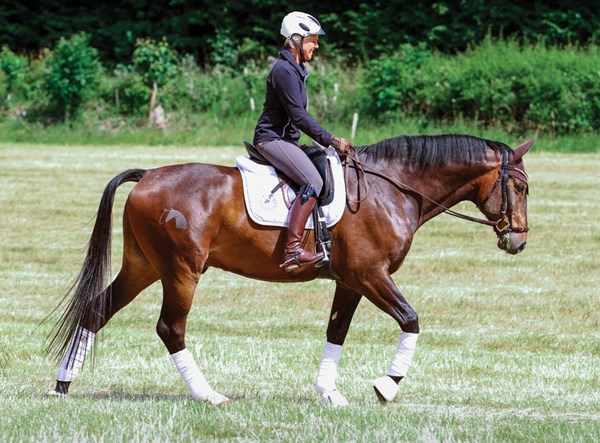
Though it is indisputable that an older horse might have special needs and require extra attention, I strongly believe that the management of a sport horse requires the same basics no matter his age. Instead of taking a wait-and-see approach with an older dressage horse, owners can avoid many common problems with proper care. At my farm, Gut Rothenkircher Hof, in Rhineland-Pfalz, Germany, our motto is “prevent instead of intervene.”
It is without question that horses are very individual entities who can develop mental and physical problems despite our best efforts. But I am convinced that the number of horses suffering from typical dressage-horse ailments can be drastically reduced by respecting two main elements while training and competing: their mental and their physical well-being, because both are closely linked.
In this article I aim to show you how you can keep your dressage horse—young or old—happy and healthy.
Keep Moving
We all know where horses once came from, how they lived and that it is their natural need to keep moving all day long. But where valuable horses whose training includes many years of dedicated work are involved, we are tempted to forget these facts. As understandable and human as these fears are, that all this work could be undone due to a severe injury, this should not prevent us from turning them out in a field with other horses. We owe it to every horse to keep him as close to nature as possible.

In nature, horses within their herd move many miles a day, mostly at a slow walk. For many owners, this situation may be impossible to imitate, but we have to try to match it as closely as possible to maintain the musculoskeletal system that is the basis of every equine athlete.
This slow, constant movement allows synovial fluid to lubricate the joints and act as a kind of cushion between the articular cartilages. If horses are standing in a stall for many hours a day, the danger is high that the joints are not sufficiently provided with synovial fluid and, as a result, begin to wear out. This only intensifies as the horse ages, especially since some wear and tear usually already exists and with increasing age, the production of synovial fluid is decreased.
It should be common knowledge among dressage riders that a horse must warm-up in a walk phase before starting to work. And while this is true, if this is the only walking a horse gets to do each day, it is not sufficient to keep his joints healthy. For this reason, all horses at my barn live in open stables consisting of box stalls and an attached grass paddock that gives them the opportunity to move around 24 hours a day. Each of them is also put in a field a few hours a day—the stallions on their own and the geldings in a herd of about 30 horses.
While awareness of the need to keep a horse moving is growing, not everybody thinks of the other factors that affect the horse’s movement, such as shoes. The shoeing of a dressage horse is a topic of its own, but many people know from their own horseshoeing experiences how harmful and painful ill-fitted shoes can be. The long-term effect on joints and the well-being of a horse can be drastically altered from improper shoeing. At Gut Rothenkircher Hof, we try to keep our horses, at the very least, barefoot behind. Given the fact that the hooves are skillfully and regularly trimmed, this is the most natural and healthy way of going for a horse. This is not always possible for various reasons, and shoeing is often necessary. But it is important to keep in mind that the shoes should hinder the natural way of a horse’s going as little as possible. Manipulating a horse’s natural way of moving by putting special shoes on will not help to keep the horse healthy in the long run.
Natural Feeding
The feeding of a dressage horse is not primarily dependent on his age but on his natural needs and the amount of work he does each day. Regrettably, I have found one of the most common health occurrences with sport horses is colic. Surely, there are horses naturally more prone to colic, and no doubt competitions present a certain kind of stress that can negatively influence the tender digestive system of any horse. But it is also the feeding regime that can contribute to such problems. It is very important to educate yourself on proper equine nutrition and to work with a qualified nutritionist when possible.
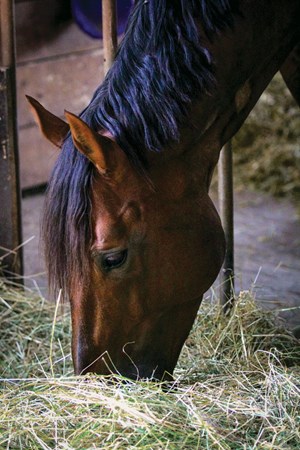
When browsing feed labels these days, one can easily get the impression that there’s a feed for every single problem, and some owners forget that horses are first and foremost grazers by nature. To work properly, the horse’s digestive system needs to have a high amount of raw fiber. So grass or the dried version, hay, is the most natural and healthiest food one can offer his horse on a daily basis.
Teeth problems mainly occur at an advanced age, and these horses can often have chewing difficulties. In this case, dust-free hay cubes soaked in water can replace the hay ration. Depending on the horse’s age, feeding type and workload, we feed our horses hard feed twice a day. Usually this is sugar-beet flakes, which we soak for 12 hours, and squeezed oats. Special hard feed for older horses seems dispensable as long as they are provided with enough energy for the amount of work they perform and with enough vitamins, minerals and trace elements.
Instead of feeding a finished mineral supplement, I always make sure to take a soil sample of my fields, a sample of my hay and a blood sample from each horse to really find out what he needs. We feed a special mixed mineral supplement based on the results of the samples to all of our horses. In winter, when the horses are not out on grass, we supplement with different minerals. It’s important to also know that too much of a mineral can have counterproductive effects. The same is true for vitamins.
Less is More: Stable Care
Owners who assume an older horse needs more extensive stable care than a younger one can mean well, but often this excessive care is not necessary as long as the horse is in a good state of health, which should be the case when he is in proper training. We keep our stable care as simple as possible because I believe many things are rather dispensable. My horses are cleaned before riding and hosed down after training so long as the temperature allows it. Each horse is closely looked after daily and any little scratches, which can occur from playing in the herd are treated.
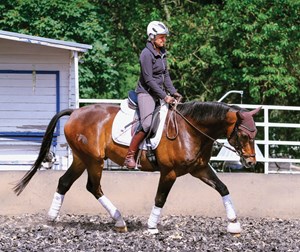
In autumn we blanket all the horses who are in serious training. The aim is to keep down an extensive growth of hair, which happens easily as we have a cold stable in which the temperature is the same as outside. The horses who will be competed during the indoor season get body-clipped. For those who are not clipped, we remove their blankets when they are out together in a herd during the day and blanket them only overnight.
Variety in Training
Every rider sets certain goals, but the highest aim should always be to keep the horse motivated and happy. Otherwise, a young horse doesn’t learn effectively and an older horse loses his sparkle and expression. You will succeed if you regard dressage as a holistic training concept, that consists of different modules: gymnastics, fitness, movements and strengthening the muscles and mind. We never train in the dressage arena more than three or four times a week. The rest of the week our bereiters lightly exercise the horses by hacking them out or longeing them without side reins to keep each of their fitness levels up. I also find that the change of rider can be beneficial for
the horses.
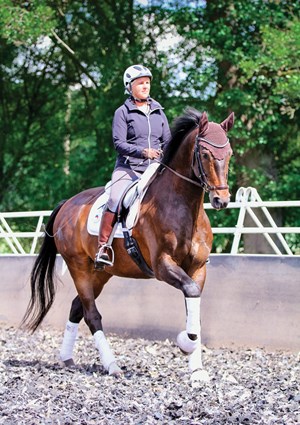
The weekly training workload of each horse varies. Normally, with a seasoned dressage horse who has established himself at a certain level, we will not practice the movements very much anymore. Instead, we put the focus on keeping him fit, supple and in a happy frame of mind so that the exertions of dressage can still be handled with ease. On the other hand, with a younger horse, we will keep the ball rolling with the learning process without overdoing it. As horses are so individual, I cannot recommend specific training schedules. Instead, I want to explain a few of our most important training principles at Gut Rothenkircher Hof, which can be applied to horses of all ages and levels:
• The motivation behind each training session has to be that you stop before the horse is overfaced physically or mentally. That is how you leave your horse wanting more.
• Start daily training with something that a horse likes and that is easy
for him. This not only fosters the horse’s eagerness, but also strengthens his self-confidence, which will be important if later you try something demanding.
• If you ask the horse to do something new or demanding, be content with a few good steps. Don’t feel tempted to try again several times or prolong it. Instead, praise and allow the horse to take a breather, either by stretching him forward and downward or by walking with giving reins.
• Often we see riders allowing the horse to stretch at the beginning and at the end of a training session. We have made it our practice to alternate between both frames during the whole training because work in elevation is demanding even for the most well-trained horse. By allowing him to stretch, we make sure that the muscles remain supple and smooth. Without the muscles remaining in that condition no good collection is possible!
• It is important to keep the horse walking a certain amount of time after work, even if he is to be turned back out in the field. This is because the muscles can recover effectively from the previous work only when they don’t cool down immediately. Walking after work prevents stiffness. Stiffness on the other hand can cause muscular tension when the horse tries to avoid the pain.
Change the Scenery
The times are long gone when dressage horses had to compete on a grassy surface. But why always train in the dressage arena? While youngsters need to learn to deal with outside influences, older horses, in particular, enjoy a regular change of scenery. Training can be relocated to a field nearby or a path in the woods. This unlevel surface teaches the horse to mind where he places his feet and to keep his balance even in different conditions. Additionally, the mutual trust between horse and rider is strengthened by the surroundings the horse has to deal with.
We go hacking in small groups with all of our horses at least once a week so they can leave their cares behind and to foster their will to go forward. This can be very beneficial when an older horse does not show significant motivation anymore in his arena work. Replace at least a few days of ring work with hacks on which you can also train movements in between.
Don’t be afraid to allow your dressage horse to have a brisk gallop across a mown field or through the forests, and let him enjoy a small jump now and then. The mental effect can be tremendous and outweighs any fears of injury. Horses usually know very well where they put their feet, and we should have confidence in them. You can also relocate the walking phases before and after training outside the arena. This may help him to be even more focused in the session after.
Management is Key
Managing a dressage horse the right way, so that he is healthy and happy doing his job, is less a question of a horse’s age, than it is paying attention to the essentials I described. If you follow through on these essentials, the health and motivation problems that can be encountered during the training of a dressage horse will be remarkably reduced unless the horse suffers from natural predispositions to a particular ailment.

Last but not least, don’t forget that every horse has only a certain amount to give in his life. How much he allows you to share with him depends on the motivation you are able to stimulate by respecting the horse’s natural needs as much as possible.
Uta Gräf is considered one of the most classical dressage riders on the current international scene. She is well known for her motivated, relaxed and contentedly working dressage horses. In 2004, she won a bronze medal at the German Championships for professionals on the former Bundeschampion Duvalier. With the licensed Holsteiner stallion Le Noir, she has won more than 25 Grand Prix classes and, in 2011, she placed in the top five at some of the most important European CDIs, including Aachen, earning a place on the German Olympic long list for London 2012. She and her partner, Stefan Schneider, live in a former monastery and train horses at Gut Rothenkircher Hof, in Rhineland-Pfalz, Germany.
Helios C: The Right Start
Helios C, an 8-year-old Hessian gelding owned and bred by Dr. Jutta Chirita from Germany, was brought to Uta Gräf as a 3-year-old and has stayed with her ever since. In the meantime, Helios has won at M-level and has debuted at S-level, placing second. (Tests at the beginning of Level S in Germany are equivalent to Fourth Level in the United States.) Chirita, who considers Helios part of the family, says, “It’s clear that for a sport horse to remain healthy for a long time, he needs a very good rearing place, a breaking-in only when he is physically ready for it, good feeding, social contacts, free exercise, an empathetic trainer, a good farrier and lots of affection.”
But there’s much more involved to keep a horse reaching his peak and remaining at that level than just taking care of the daily training and feeding. If one wants an equine athlete to remain healthy for a long time, there can be no short cuts at any point in his career. “Though only the future will show, Helios received the best preconditions to enjoy a long, healthy and happy career in the dressage arena,” says Chirita. “I hope that he will remain healthy enough to offer my grandchildren their first longe lessons in 10 years or so. That would be the best.”
Ahlerich: A Decade at the Top
The Westfalian gelding Ahlerich was the most successful horse of the late Dr. Reiner Klimke. What’s more, the horse stayed at the top of his game for more than a decade. Dressage Today asked the legendary rider’s wife, Ruth, about the secrets behind Ahlerich’s longevity in the sport.
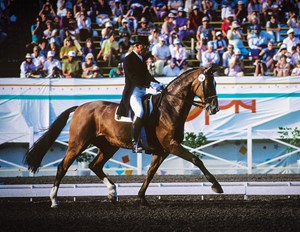
DT: Why was Ahlerich able to compete internationally with tremendous success for more than a decade?
Ruth Klimke: I am convinced it had been his truly good training. At the beginning, he wasn’t a physically strong horse; he had a weak, long back. It was the right work that made him stronger and capable of the work. But to build up his physique took time. We did a lot of gymnastics, jumping and cavalletti work. We always took great care to make sure that he was warmed up as long as he needed, first in walk and then by riding him first low and deep. Back then, my husband was always short of time as he worked full-time, so Ali wasn’t ridden too often. The opportunities back then were not the same as today and one also had time to give horses a learning phase without shows over the winter.
DT: The physical condition is one thing. How about the mental side?
Ruth Klimke: This is a very important factor. With our long-time groom, Claudia Rosner, Ali found a friend who took care of him from his very first to his very last day, 17 years. We spent a lot of time with him besides the training and made a fuss of him in the stable. I taught him tricks like nodding and giving a front leg to say “hello.” Another factor that kept him mentally motivated was that we never focused strictly on dressage. Of course, if there was a movement that needed refinement we asked for that for a few days, but then forgot about it for a while. Also, we purposefully built him up for the shows and after we kept him happy and entertained with long hacks and worked him like a younger horse.
DT: Ahlerich was known to be a fussy eater. How did you keep him in shape, in particular in stressful situations at shows?
Ruth Klimke: We had to find food he liked. Claudia was very successful with that. Once we found a feeding routine, it worked quite well. We fed squeezed reform oats together with sugar oats because they tasted sweet. I also cooked fresh bran for him and fed him fresh artichokes. This he got three times a day together with hay. Additionally, we always fed all of our horses lots of carrots and some apples each day. At shows Ali just needed his usual routine and people around him, particularly when he was young.
Next month, German Grand Prix rider Sabine Becker discusses the importance of listening to your dressage partner and what she learned from her 18-year-old Grand Prix horse, Lamarc.











